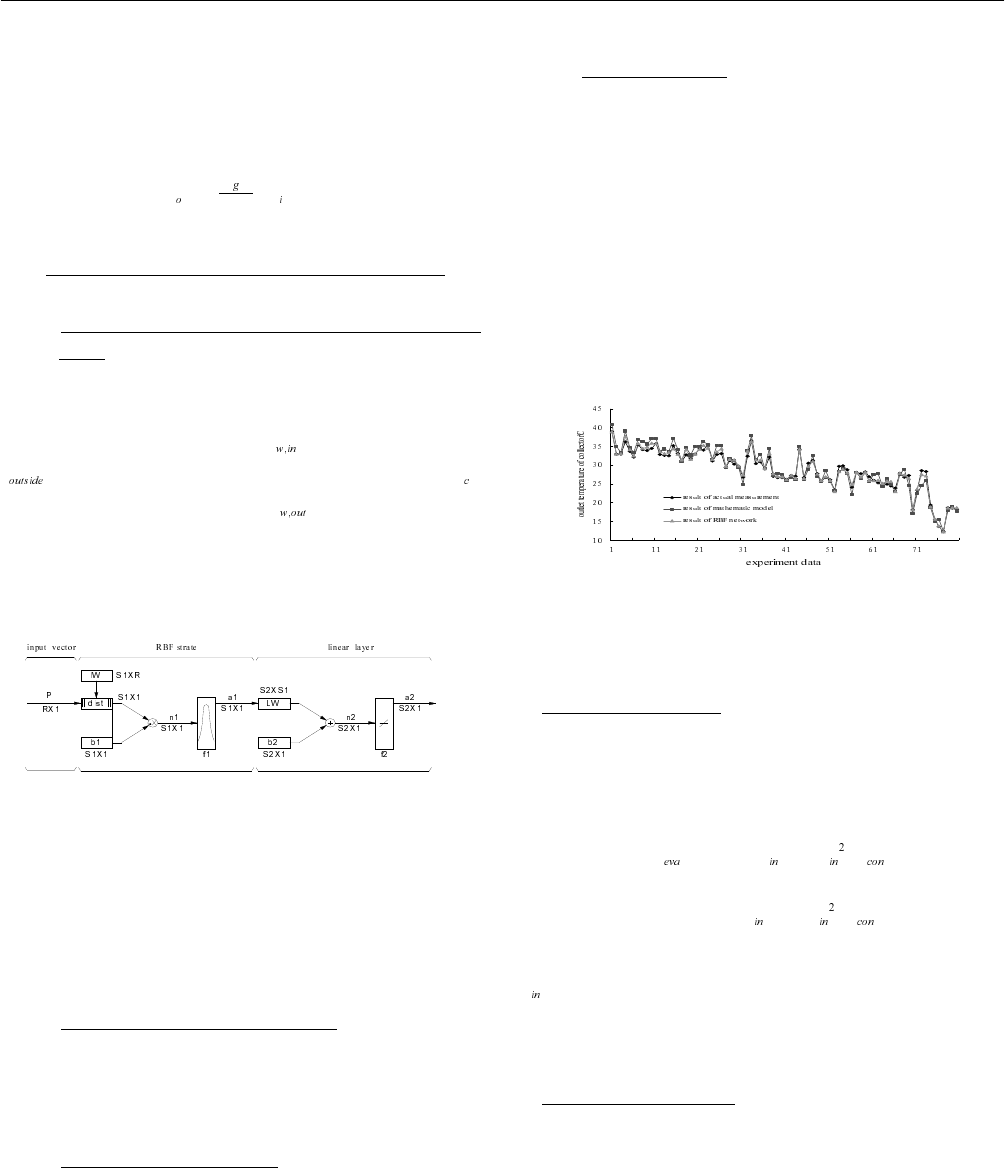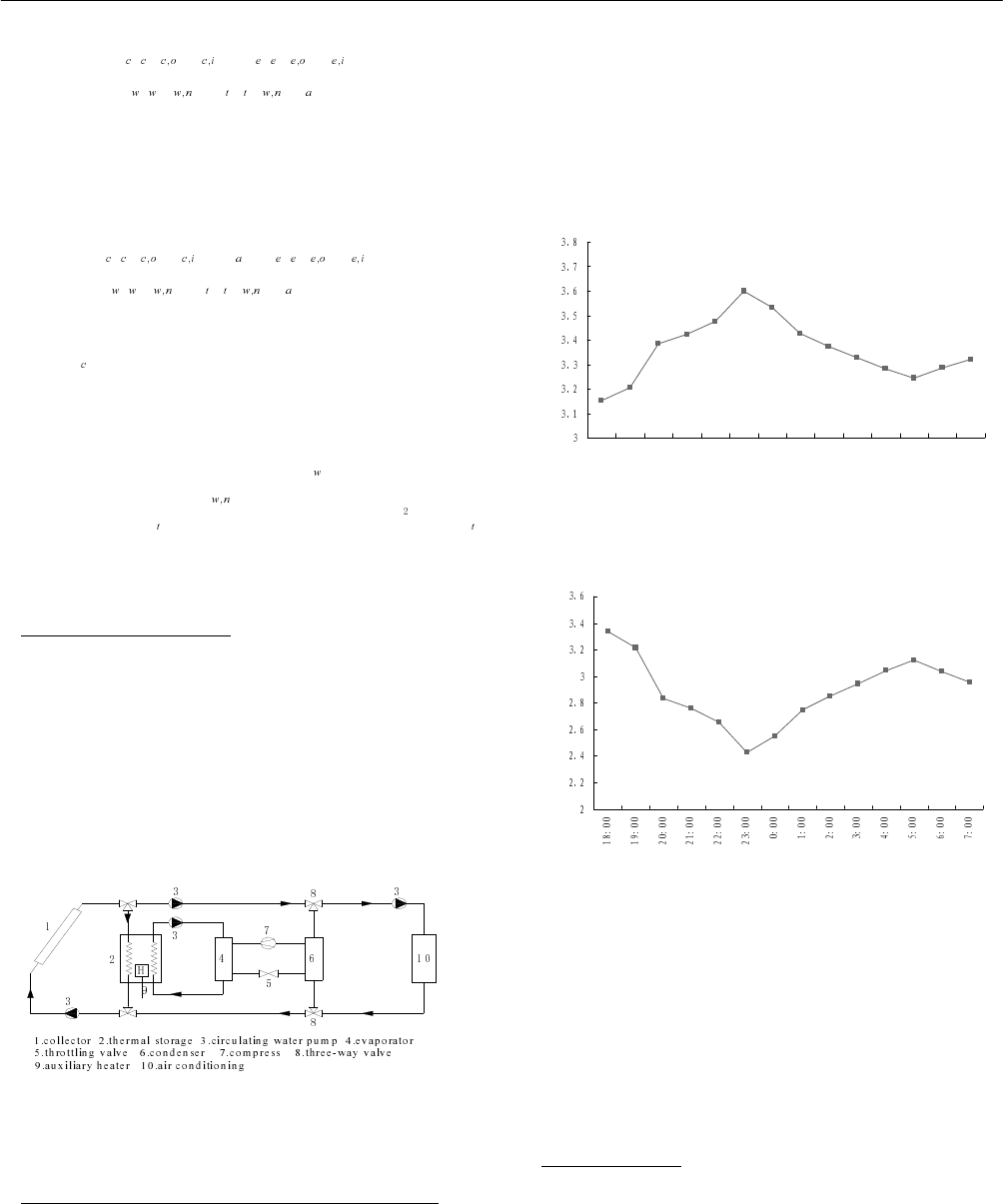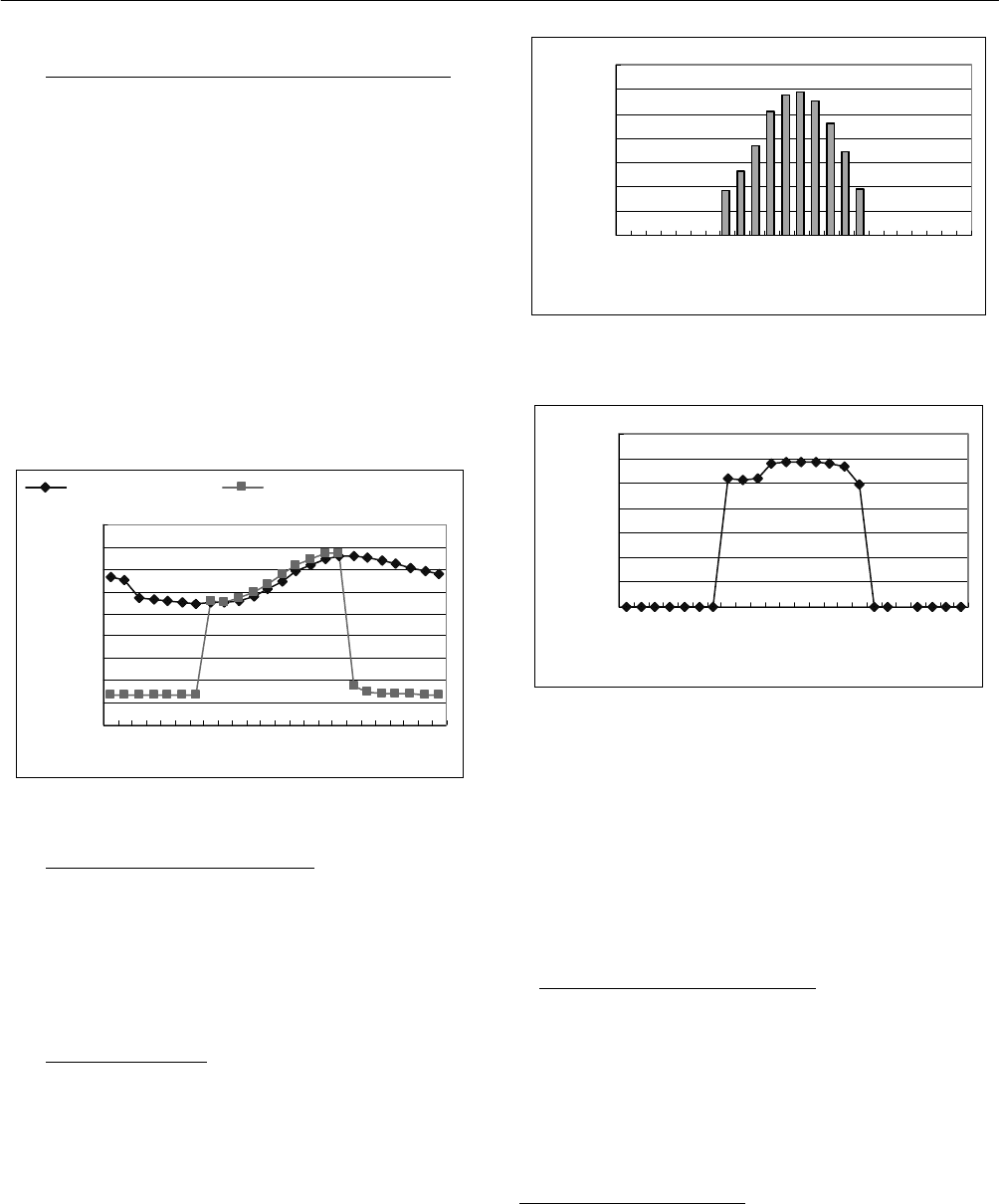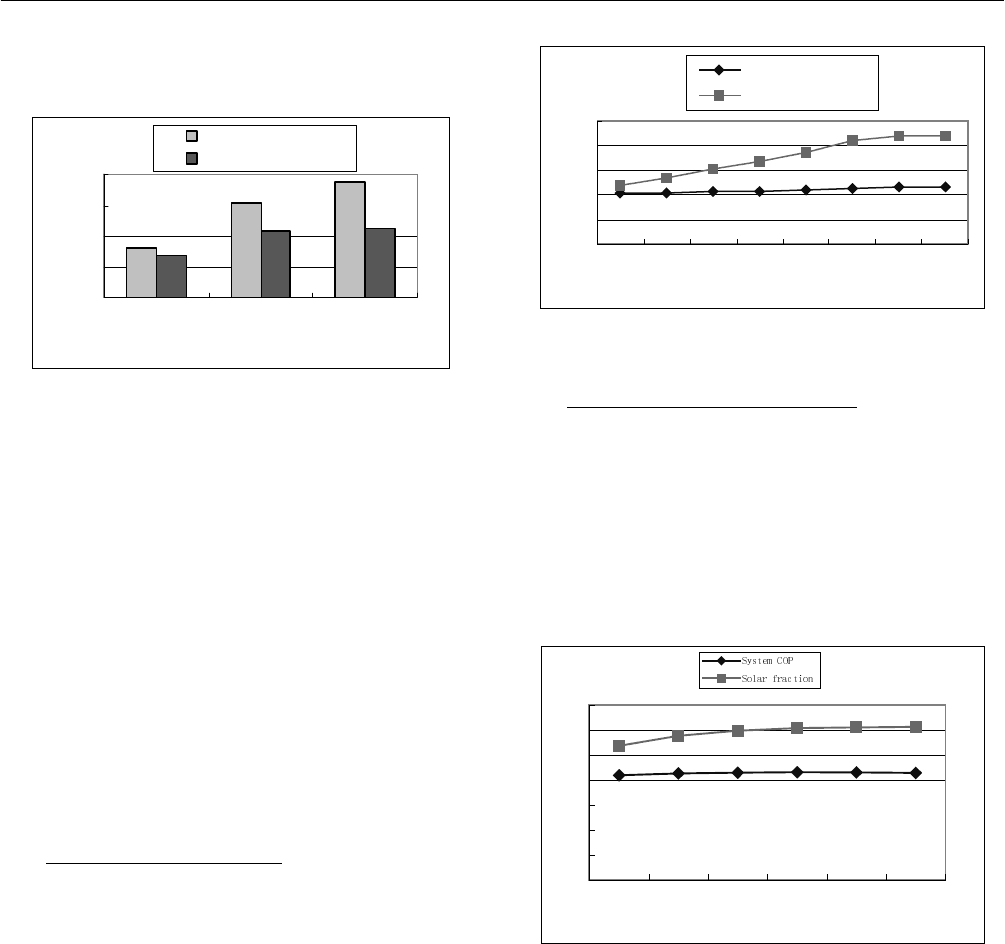Труды Всемирного конгресса Международного общества солнечной энергии - 2007. Том 2
Подождите немного. Документ загружается.


Proceedings of ISES Solar World Congress 2007: Solar Energy and Human Settlement
832
heat source) during 24h. However, the demand for hot
water in the Natural Medicine Ward varies significantly
during 24h. The utilization of waste heat from sewage
water caused the necessity of introduction of storage tanks
with total capacity of 80 m
3
(each has 40 m
3
). Usually the
total sewage volume dumped during approximately 8 hours
is about 55 m
3
. The sewage bathes are taken between 7 a.m.
to 3 p.m. six days per week, without Sundays. The peak
hours of treatment are from 8.30 a.m. to 12 a.m. Apart from
the daily peak hours there are also peak months, and these
are from May to September (including). During peak
months it is about 65 m
3
of
sewage water per day. In the out
off season months, i.e. December – January, it is about 45
m
3
or even less.
5. FINAL RESULTS OF MODERNISATION
Due to 2
nd
phase of modernization total final space heating
energy was reduced by 2952 MWh/year and total hot water
final heating energy requirements by 3190 MWh/year. Total
hot water heating energy supplied by renewable energy and
heat recovery systems is equal to 716 MWh/year, what
constitutes about ¼ of the total hot water demands. The
annual energy input from solar energy and waste heat is
following:
Solar collectors: 231.7 MWh/year
Heat recovery from sulphur sewage supplied by the heat
pumps: 461 MWh/year
Heat recovery from ice water machine supplied by the heat
pump: 23 MWh/year
During first years of operation of the solar system it turns
out that there is a problem with too much solar radiation in
summer. To avoid this situation the solar system will be
upgrading by introduction of bigger storage volume and
improved control system, to assure that all available solar
radiation can be used.
Nowadays, primary energy for heating purposes from fossil
fuels is about 7.901 GWh/year, with primary energy for:
Space heating: 4.298 GWh/year
DHW and technological hot water: 3.603 GWh/year
However, the total annual primary DHW and technological
hot water heating energy is equal to 4645 MWh/year, with
primary energy from renewables or heat recovery equal to:
1042.2 MWh/year, with the following components:
Solar energy: 337.5 MWh/year
Heat from sulphur sewage: 671.2 MWh/year
Heat recovery from ice water: 33.5 MWh/year
After the 2
nd
phase of modernization CO
2
emission
accounts for 1 580.2 tons/year, with 859.6 tons/year
because of space heating energy (about 55%) and 721.6
tons/year of DHW and technological hot water heating. The
primary energy savings because of utilization of solar
energy and recuperation of waste heat give reduction of
CO
2
emission about 265.5 tons/year.
Nowadays, besides substantial energy and fuel savings, the
attractiveness of the sanatorium (and the entire region)
benefits as a facility that utilizes modern and unconven-
tional solutions for energy saving and environmental
protection. Modern sanatorium facilities show that the
environment condition should be considerate while taking
care directly of patient's health and well-being. The
further improvement of indoor climate through introduction
of new HVAC systems in more building spaces and
reduction of energy consumption, including better
utilization of solar energy, is to be developed in the next
energy modernization phase.
6. ACKNOWLADGMENTS
Thermal modernization aspects and polygeneration
problems using Busko example as a case study are addressed
in the CAMELIA project realized under the VI
Framework Programmes of the EU projects (contract No.
TREN/04/FP6EN/S07.31777/506486).
7. REFERENCES
(1) National Standards. PN-B-02025
:2001. Annex C.
(2) D. Chwieduk, D. Koc. “Utilization of waste heat and
solar energy in “Wlokniarz” sanatorium in Busko
Zdrój”. Conceptual study and report elaborated for
internal use of sanatorium. 2004.
(3) D. Chwieduk, D. Koc. Internal reports on Busko Zdroj
as a case study for CAMELIA project. 2005- 2007.

THE SIMULATION RESEARCH OF SOLAR ASSISTED HEAT PUMP
SYSTEM WITH THE NEUTRAL NETWORK
Wang Kai, Fan Bo, Zhang Yilin, Xia Qi
Qingdao Technology University
Qingdao266033, China
WKWX5201314@163.com
ABSTRACT
This paper mainly explores the simulation studies for
SAHP system and takes the heating system as research
object , sets up the heat pipe evacuated tubular collectors
model with the neutral network. Based on the RBF neural
network, the predictor-corrector model of collector model
is built, as well as a steady-state model of heat pump, heat
storage tank model and indoor thermal load model are set
up. The validation of simulation model is verified in a
Qingdao’s building which is equipped with SAHP system ,
and the simulation is applied with the heating condition for
winter. The results show that the system simulation model
and program is feasible. Through calculation by the
simulation model, the performance of SAHP system is
analyzed and the saving heat by the solar collectors is
obtained in the whole heating season.
1. INTRODUCTION
For the shortage of energy sources and the environmental
pollution derived from energy utilization, the R&D of clean
and renewable energy sources become more important.
Solar energy, as clean and renewable energy source, has its
particular advantage. It is a promising heat supply mode,
which combines solar energy whit heat pump (SAHP). This
takes the heating system as research object and sets up the
heat pipe evacuated tubular collectors model, heat pump
model, heat storage tank model, as well as introduces the
RBF neural network as proof techniques, sets up
predictor-corrector model of collector model based on the
neural network.
2. COLLECTOR MODEL WITH THE RBF NETWORK
2.1 Collector Deterministic Model
According to reference
[1], efficiency equation of the heat
pipe evacuated tubular collector:
()
A
TT
FU
AI
ητα
⎛⎞
−
⎡⎤
=−
⎜⎟
⎢⎥
⎜⎟
⎣⎦
⎝⎠
˄1˅
There
F is collector heat removal factor, when number of
evacuated tubular is n,
F can be calculated by equation:
'( 1 )FG
F
N
−
=
˄2˅
There A
p
is significant heat-collecting area, m
2
, A
g
is
daylight area of collector; Ac is the heat pipe evaporates
section area;
U is total loss of heat coefficient; 'F is
collector efficient factor.
()mc T T
AI
η
−
=
(3)

Proceedings of ISES Solar World Congress 2007: Solar Energy and Human Settlement
834
T
i
is temperature of fluid into collector, ; T
o
is temperature
of fluid outflow collector;
Though eq.(1)~(3),T
o
can be calculated by:
AI
TT
mc
η=+
(4)
2.2 The Neutral Network Adjustment Model Building
2.2.1 Neuron Number Of Input Layer And Output
Layer[2]
Paper
Neuron of input layer include: medium flow
w
v ˈ
water temperature into collector
t ˈ outside temperature
t ˈsolar radiation intensity
I
, area of collector
A
,
output of deterministic mode
't . Neuron of output
layer is temperature of fluid outflow collector.
Figure 1 shows the RBF network structure.
Fig. 1: RBF network model.
Eq.(5) and (6) is expression of output RBF network:
212aLWab=×+ (5)
1( ) (|| ( ) || 1( ))a i radbas IW i P b i=−⋅ (6)
2.2.2 Neuron Number Of Implicit Layer
Neuron number of implicit layer is chosen by newrb
function.
2.2.3 Network Transfer Function
Transfer function of implicit layer is Gauss function.
Transfer function of output layer is pureline function.
2.2.4 Data Pretreatment
Base on Qingdao’s climate characteristic, five hundreds and
fifty-three groups experimental data is gathered from Jan
15 to Nov 10 in 2006.Half experimental data is selected as
the training sample data, as well as the data is normalized.
Figure 2 shows different of the output of deterministic
model, predictive correction model and measured
result .The accuracy of collector deterministic model is
adjust by that the network study deviation between result of
analogue computation and experimental data.
Fig. 2: The output of deterministic model,predictive
correction model and measured result.
3. SAHP UNIT MODEL
[3]
According to sampled data of heat pump unit, relation
between exotherm and input power can be fitted.
()QabtctQ=+×+× (7)
()Wdet ftQ=+×+× (8)
t is temperature of cooling water into condenser,
,,, ,,abcd e fis curve-fitting factor.
4. THERMAL STORAGE
When water temperature of thermal storage tank is belower
than range of set value, auxiliary thermal source is turn on.
When auxiliary thermal source is off, heat balance equation
of thermal storage tank:

3 SOLAR COLLECTOR TECHNOLOGIES AND SYSTEMS
835
( ) ( )
()
mc t t mc t t d
Mcdt UAt t d
τ
τ
−− −
=+−
˄9˅
when auxiliary thermal source is on, heat balance equation
of thermal storage tank:
( ) ( )
()
mc t t Q mc t t d
Mcdt UAt t d
τ
τ
−+− −
=+−
˄10˅
Where
m
and
e
m
are mass flow of fluid in collector and
evaporator, kg/s;
c
c and
e
c are mean specific of fluid,
J/kJgć;
,ci
t and
,co
t are inlet and outlet temperature of
fluid in collector,ć;
,wn
t and
a
t are fluid temperature of
thermal storage and outside, ć ;
M is fluid mass in
thermal storage, kg;
dt is fluid temperature rise in
thermal storage;
U is heat loss coefficient, W/m gć;
A
is heat emission area, m
2
.
5. SAHP SYSTEM MODEL
[4]
SAHP system is consisted of heat pump unit model, solar
collector model, water tank model and air conditioning
equipment model. According to principle of mass
conservation and coupling relation of each part model,
principle of conservation of energy, quasi-stable state
mathematical model of SAHP system is established.
Fig. 3: shows the SAHP system.
6. PERFORMANCE ANALYSIS OF SAHP SYSTEM
The total floor area of two-storey building which locate at
the city of Qingdao is 180.00 square meters. Design
parameter of air conditioning: normal operation:
conditioned space is 150 m
2
, indoor temperature is 20ć,
relative humidity is 40%; frostproof operation: indoor
temoerature is greater than 10ć.relative humidity is 30%.
Figure 4 and Figure 5 show COP and input power of SAHP
unit change tendency in typical day.
tim e
&23
Fig. 4: COP of SAHP unit change tendency.
time
input power/K
W
Fig. 5: Input power change tendency.
According simulating analysis of SAHP system in typical
day, load of SAHP system is 120.2 kWgh, heat-collecting
capacity of collector is 80.1KWgh, auxiliary heat quantity
is 20 kWgh. Input power of heat pump unit is 40 kWgh.
About 8500 kWgh heat quantity is saved in the whole
heating season
7. CONCLUSIONS
The neutral network model of collector is building,
different of the output of deterministic model, predictive
correction model and measured result is analyzed. The

Proceedings of ISES Solar World Congress 2007: Solar Energy and Human Settlement
836
simulation model of SAHP system is built. The energy
consumption of SAHP system is calculated by simulation
model is whole heating season.
8. REFERENCES
(1) N.Fraidenraich,R.Dec.F.Delim. “A Tiba.Simualtion Model
of a CPC Collector with Temperature-dependent Heat
Loss Coefficient[J]”.Solar Energy,1999, 65(2), 99-110
(2) Moller. “M.F.A Scaled Conjugate Gradient Algorithm
for Fast Supervised Learning”. Neural Network, 1993,
vol.6, 520-535
(3) M.Inalli. “Design Parameter for Solar Heating System
with an Underground Cylindrical Tank[J]”. Energy.
1998,23(12)˖1015-1027
(4) Yang Weibo, Shi Mingheng, Dong Hua. “Numerical
Simulation Of the Performance of A Solar-earth Source
Heat Pump System [J]”. Applied Thermal Engineering,
2006,26(18):2367-2376

RESEARCH ON SOLAR HIGH-TEMPERATURE ABSORPTION AIR-
CONDITIONING SYSTEMS
Guoqing Yu, Jinhua Tang, Zhijun Zou
Department of Building Environment and Equipment Engineering
University of Shanghai for Science and Technology
Shanghai 200093, China
guoqing.yu@163.com
ABSTRACT
This paper studies the characteristics and performance of
solar higher-temperature absorption air conditioning
systems which employed linear concentrating collectors
and double-effect absorption chillers. A solar
higher-temperature absorption air conditioning system was
designed for a small house. Hourly simulations during a
cooling season have been conducted using typical
meteorological year (TMY) data. Simulation results show
that the solar air conditioning system have excellent
thermal performance. The linear concentrating collectors
can produce hot water of temperature as high as 120-160
o
C
and the COP of the double-effect absorption chillers can
reach 1.2-1.4. The system COP during a cooling season
can reach 0.426. Meanwhile, the effects of some factors
such as climates, volumes of storage tank, areas of
collectors on the performance of this solar air conditioning
system are also discussed.
1. INTRODUCTION
As the shortage of fossil energy sources and environmental
pollution have become the bottleneck of sustainable
development of the whole world, utilization of solar energy
is one of the important ways to mitigate energy shortage.
Solar air conditioning has attracted much attention from
scholars and engineers.
At present, most solar assisted air conditioning systems
employ evacuated tube collectors with outlet temperature
of 70-90
o
C and single-effect absorption or adsorption
chillers. The overall system Coefficient of Performance
(COP) of solar air conditioning (which is defined as the
ratio of refrigerating capacity to solar radiation incident on
the collector aperture) is as low as only 0.2-0.25, because
of the low COP (typically 0.4-0.7) of the single effect
absorption or adsorption chillers [1,2].
This paper introduces high-temperature absorption
air-conditioning system which employs linear concentrating
collectors and double-effect absorption chillers. The
chillers of the solar air conditioning systems are driven by
high temperature hot water produced by linear
concentrating collectors. The driving hot water temperature
can get to as high as 120-160
o
C, and the COP of chillers
can reach 1.2-1.4. The expected overall COP of the solar
cooling systems is 0.4-0.5.
A typical house was selected and a solar high temperature
absorption air conditioning system was designed for the
house. The capacity of main components of the system was
determined too. This paper conducts hourly simulation of
the solar air-conditioning system during a typical cooling
season. Some factors which affect the performance of the
system were also studied.

Proceedings of ISES Solar World Congress 2007: Solar Energy and Human Settlement
838
2. DESIGN OF A SOLAR HIGH TEMPERATURE ADS-
ORPTION AIR-CONDITIONING SYSTEM
2.1 The Cooling Load
The solar high-temperature absorption air-conditioning
system will be setup for a typical old house in a university
campus in Shanghai which will be retrofitted as a model of
high energy efficiency. The overall area of this building is
120m
2
. There are two windows in the south wall whose
area are both 6m
2
. We assume 5 people living in the house
and the energy input due to light, computer, etc are
2000KJ/hr. The set temperature for cooling is 26
o
C and it
needs air conditioning all day during summer.
2.2 The Main Components of the System
A solar high-temperature absorption air-conditioning
system was designed for the house. The schematic of the
solar air conditioning system is shown in Fig. 1. It mainly
includes the following components:
T
T
T
Fig. 1: Schematic of the solar high-temperature absorption
air-conditioning system.
(1) Collectors: In order to get high-tmeperature water,
linear parabolic concentrating collectors were employed in
the system. The concentration ratio of the collector
employed in this system is 25. Total aperture is 60 m
2
.
The collectors are positioned east-west and oriented to
due south. They are rotated around a horizental axis. The
efficiency of collectors is formulated as[3]
QTT
ab
A
IIC
η
−
==−
.
where,
a- intercept efficiency which is 0.7 in this case;
b- negative of the first-order coefficient of the efficiency
curve which is 4.167W/(m
2
g
o
C);
T
i
- inlet fluid temperature to collectors(
o
C);
T
a
- the ambient temperature(
o
C);
C- concentration ratio;
I
bT
- beam radiation on collector aperture surface (kJ/m
2
gh);
A
c
- Collector aperture area (m)
The modifiers of incidence angles for solar beam radiation
in the simulations are taken into consideration.
(2) Chiller: A double-effect absorption chiller is employed
in this system and its maximum cooling power is 16kW. A
chiller of 10kW is enough for the cooling purpose in this
case, but the minimum capcacity available from the market
is 16kW.
(3) Storage tank: The volume of the tank is 2.0m
3
for the
basic case.
(4) Auxiliary heater: When the solar power is not enough,
a auxiliary heater is required to heat the supply hot water to
120
o
C if the inlet temperature is less than 120
o
C. The
maximum heating power of the auxiliary heater is 10 kW.
3. SIMULATION OF THE BASIC CASE
In order to study the characteristics and performance of
solar higher-temperature absorption air conditioning
systemsˈhourly simulations are conducted on the basic case
described in the above section. The hourly data during the
cooling season of typical meteorological year (TMY)
comes from [4].
3.1 Overview of Results
Some overall indice of performance during a whole
cooling season are obtained by simulations. The
collector average efficiency is 37.5%, the system COP
is as high as 0.426 . This is because the driving hot
water’s temperature is so high that the double-effect
absorption chillers in this system can obtain high COP
which is mainly between 1.1 and 1.4.

3 SOLAR COLLECTOR TECHNOLOGIES AND SYSTEMS
839
3.2 Outlet Temperature of Storage Tank and Collectors
The water temperature out of collectors and storage tank is
very important for the normal operating of the solar cooling
system. As shown in Fig. 2, in a typical clear summer day
the storage tank outlet temperature is between 110
o
C and
150
o
C. In the early morning from 1:00 to 7:00 and in the
later afternoon from 18:00 to 24:00 the outlet temperature
of collector is lower because of no solar radiation and heat
loss to ambient. At time 8:00−17:00, the outlet temperature
rises from near ambient temperature to high until the
highest (near 150
o
C) and then drops. There is no great
variation of tank water temperature during night due to
good insulation and heating from the auxiliary heater.
7,0(
2XWOHWWHPSHUDWXUH&
7DQN7HPSHUDWXUH &ROOHFWRU7HPSHUDWXUH
Fig. 2: The hourly outlet temperature of tank and collectors.
3.3 Useful Heat Gain from Collectors
The hourly useful heat obtained from collectors in a typical
summer day for the basic case is indicated in Fig. 3. They
are higher in middle and lower in two sides. It is easy to
understand.
3.4 Collector Efficiency
The hourly collector efficiency of a typical summer day for
this case is shown in Fig. 4.
It indicates that in the clear summer day the efficiency of
the linear parabolic concentrating collectors is between
50% and 60% during the daytime and it reaches to nearly
60% around noon. It is much higher than the average
7,0(
&ROOHFRWU +HDW*DLQ0-
Fig. 3: The hourly useful heat gain from collectors.
7,0(
&ROOHFWRU( IILFLHQF\
Fig. 4 The hourly collector efficiency.
collector efficiency (37.5%) during a whole cooling season.
Considering the COP of chiller of 1.2-1.4, the system COP
in a clear summer day will be 0.6-0.8, which is much
higher than the 0.2-0.25 in conventional solar air
conditioning systems.
4. ANALYSIS AND DISCUSSIONS
In order to find out how factors, such as climates, volumes
of storage tank, areas of collectors, affect the performance
of thus solar air conditioning systems, some additional
simulations have been conducted and some valuable
conclusions were obtained.
4.1 The Effect of Climates
In this case, only meteorological data was changed to
Guangdong and Beijing respectively while all other

Proceedings of ISES Solar World Congress 2007: Solar Energy and Human Settlement
840
parameters are the same as the basic case. The results of
simulation are shown in Fig. 5:
*XDQJ]KRX 6KD QJKDL % HLMLQJ
'LIIHUHQW&LW LHV
6RODUIUDFWL RQ
6\VWHP&23
Fig. 5: The performance in different climates.
We can see in Fig. 5, the solar fraction of the system in
Beijing is the highest, Shanghai is the second and
Guangdong is the third. It is very hot in summer in all of
the three cities, so there is no large difference in cooling
load in them. The performance difference is mainly due to
the fact that the solar radiation source in Beijing is better
than that in shanghai and shanghai is better than
Guangdong.
The system COP of the three cities has the same trend as
solar fraction. In additional to the best solar radiation in
Beijing, the highest COP is also due to the dry weather in
Beijing which will results in lower condenser water
temperature and higher chiller COP.
4.2 The Effect of Collector Areas
The effect of collector areas on the performance of this
kind of solar higher-temperature absorption air
conditioning system is studied here. During the simulation,
the collector area is changed from 50m
2
to 85m
2
, the result
are shown in Fig. 6.
As shown in the Fig.6, the higher the collector area is, the
higher the system COP. However it is worth noting that the
solar fraction increases slowly after collector area is more
than 70m
2
. The system COP is insensitive to collector area
and increases little corresponding to very large collector
area variation. Solar fraction is not suitable to be greater
than 80% in this case.
7KHFROOHFWRU DUHDP
6\VWHP&23
6RODUIUDFWL RQ
Fig. 6: Effect of different collector area on the system.
4.3 The Effect of Storage Tank Vo l um e s
Fig. 7 shows the results of simulation about the effect of
storage on the performance of this air-conditioning system.
From Fig. 7 we can see that the tank volume has little effect
on the system COP. Bigger storage tank means lower water
temperature and higher collector efficiency but lower
chiller COP.
7DQNYROXPHP
Fig. 7: Effect of tank volumes on the system.
The solar fraction increases little after the volume is greater
than 1.4m
3
. A tank of 1.4 m
3
is enough for this case. For
this kind of solar high-temperature absorption
air-conditioning system, smaller tank volume is suggested
compared to the 40-100L per collector area in solar
domestic hot water and space heating systems. This is
mainly due to the good match between cooling load and
solar radiation.

3 SOLAR COLLECTOR TECHNOLOGIES AND SYSTEMS
841
5. CONCLUSIONS
(1) The solar high-temperature absorption air-conditioning
systems which employs linear concentrating collectors and
double-effect absorption chillers have excellent thermal
performance. The linear concentrating collectors can
produce high temperature water as high as 120-160
o
C and
the COP of the double-effect absorption chillers can reach
1.2-1.4. The system COP can reach 0.4-0.5.
(2) The performance of this kind of solar high-temperature
absorption air-conditioning systems is affected by weather
conditions. It is best in Beijing, then in Shanghai and
Guangzhou.
(3) The greater the collector area is, the higher the solar
fraction are. However when the area is more than a certain
value ( 70m
2
for this case), the solar fraction increases little
corresponding to much larger collector area.
(4) The on the system COP and solar fraction is insensitive
to storage tank volumes. Smaller storage volumes than
that in solar domestic hot water or space heating systems
are suggested for these systems. .
6. ACKNOWLEDGEMENTS
The research is financed by Shanghai Education Committee
Development Foundation (06EZ005).
7. REFERENCES
(1) Hans-Martin Henning, 2003. Solar assisted
Air-Conditioning in Buildings. SpringerWienNewYork.
(2) Ruzhu Wang. 2007. Solar Refrigeration. Chemical
Industry Press(China).
(3) JohnA Duffie, William A.Beckman. 1991. Solar
Engineering of Thermal Processes (2nd ed.).New York:
Wiley (USA).
(4) China Weather Bureau, TsingHua University. 2005.
Special databse for building thermal environment in
China. China Architecture & Building Press. (China).
